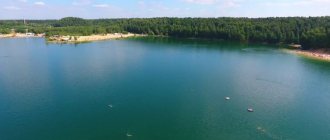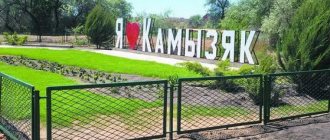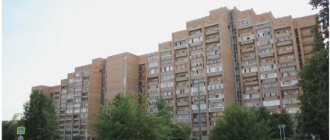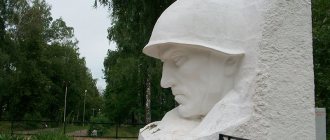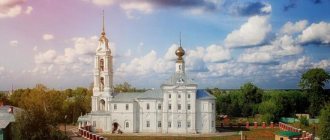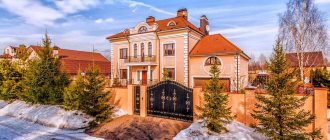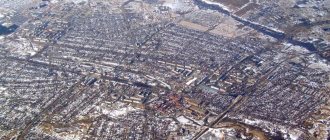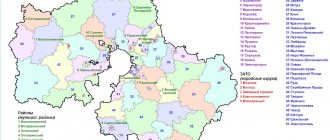| Serpukhov |
Serpukhov
, a city in Russia, the administrative center of the Serpukhov urban district within the Moscow region, the titular city of the Serpukhov Vicariate of the Patriarch of Moscow and All Russia within the Podolsk diocese. Located in the southern part of the Moscow region on the Nara River, 99 km from the center of Moscow. Railway and road transport hub, river port. Population - 125.5 thousand (2021).
- On the map: Yandex.Map, Google map
The official founding date is 1339 (other versions: 1328, 1336).
In 1341 - 1456 - the center of the Serpukhov-Borovsky inheritance as part of the Moscow Grand Duchy.
In 1360, Metropolitan Alexy of Moscow founded the Vladychny Monastery. In 1374, construction of a wooden Kremlin began. In the same year, Prince Vladimir Andreevich the Brave founded the Vysotsky Monastery.
In 1380, Serpukhov became one of the centers of preparation for the campaign against Mamai. The Serpukhov militia, led by Prince Vladimir the Brave, acted as part of the Ambush Regiment in the Battle of Kulikovo, which became a turning point in Russian history.
With the loss of independence, Serpukhov was included in the feeding system. In 1496-1502, in the feeding of the Kazan Khan Muhammad-Amin. In 1532-1533, in the feeding of the Kazan Khan Shigaley.
Serpukhov was repeatedly attacked and besieged: in 1382 by the troops of Tokhtamysh, in 1408 by Edigei, in 1410 by Svidrigailo.
With the construction of the stone Kremlin in 1556 by decree of Ivan IV the Terrible, Serpukhov became a significant fortress on the southern Russian borders. In 1618, it withstood a siege by the troops of the Ukrainian Hetman Sagaidachny.
In the 16th-17th centuries it was a large trade and craft center. Iron mining and processing, tanning and other crafts were developed. Built: the Church of St. Nicholas (on the site of the current cathedral), the Gate Church of the Three Saints, the walls and towers of the Vladychny Monastery, the Church of the Intercession in the Baroque style, the Church of Athanasius of Athos (dismantled in 1878), the new building of the Trinity Cathedral. In 1627, the Cathedral of the Conception in the Vladychny Monastery was rebuilt.
Since 1708 - as part of the Moscow province, since 1719 - in the Moscow province. Since 1781 it has been a district town in the Moscow province.
At the beginning of the 18th century, factories for the production of sailcloth (30% of the country's total sailcloth) appeared in Serpukhov. Since the end of the 18th century, the textile industry (cloth and calico) has been developing. By the middle of the 19th century, Serpukhov was the largest textile (cotton production) center in the Moscow province. In 1856, in the district town of Serpukhov, Moscow province, there were 22 churches. By the end of the century, in terms of population, Serpukhov took first place in the Moscow region - 30 thousand inhabitants (1897).
Textile production in Serpukhov at the turn of the 19th century developed rapidly. It was almost unaffected by the economic crisis. “Russian Manchester in miniature,” journalists described Serpukhov.
During Soviet times, Serpukhov became a significant industrial, cultural and scientific center. The leading industries of the city are mechanical engineering and metalworking, textile and food industries.
In 1934, the Kremlin was dismantled for material for the construction of the Moscow Metro. Only two tiny fragments of walls remained on the Kremlin hill. The destruction of the Church under Soviet rule led to the fact that only one Church of Elijah the Prophet operated in the city.
Where is the city of Serpukhov?
Serpukhov is the administrative center of the Serpukhov urban district within the Moscow region.
The city is located in the southern part of the Moscow region on the Nara River. The southern part of Serpukhov occupies the northern slopes of the Central Russian Upland, the northwestern part - the Smolensk-Moscow Upland. The approximate population is 124 thousand people, the area of the city is 32 square kilometers. The climate in the city is temperate continental, which is determined by the influence of the transfer of air masses from southwestern and western cyclones. The annual precipitation rate is 584 mm. Air pollution levels in the city are often exceeded. The main cause of environmental problems is the emissions of harmful substances into the atmosphere by industrial enterprises.
Serpukhov is located in the same time zone as Moscow, the offset relative to Coordinated Universal Time (UTC) is +3.
New documents
Pamukkale and the ancient city of Hierapolis
Decree of the Government of the Moscow Region No. 271/12 dated April 13, 2021 On approval of the Procedure and conditions for assigning a monthly cash payment for a child aged three to seven years inclusive Order of the Ministry of Social Development No. 21РВ-229 dated December 30, 2020 On approval administrative regulations for the provision of state by the Ministry of Social Development of the Moscow Region Order of the Ministry of Social Development No. 21РВ-230 dated December 30, 2020 On approval of the administrative regulations for the provision of state by the Ministry of Social Development of the Moscow Region. Order of the Ministry of Social Development No. 21РВ-227 dated December 30, 2020 On approval of administrative regulations for the provision of state.
Serpukhov Airport
Serpukhov does not have its own airport. The nearest operating international civil airport is Domodedovo, which is located in Moscow. The distance from Serpukhov to the airfield is 76 km. Airport type: civil. Operating hours: 24 hours a day.
The airport serves aircraft of major Russian and international airlines: Emirates, British Airways, Austrian Airlines, NordStar Airlines, S7 Airlines, Severstal. Popular destinations of regular and charter flights: Ekaterinburg, Anapa, Dushanbe, Geneva. The annual passenger traffic of Domodedovo Airport is more than 29 million people.
Serpukhov peacocks
The peacock is one of the symbols of Serpukhov, which is depicted on its coat of arms. At first this is surprising, because, it would seem, where is Serpukhov and where are the peacocks? How can they even be connected?
It turned out that the coat of arms with a peacock appeared back in the 1720s. It was compiled by heraldist Franz Santi, who came to Russia at the invitation of Peter I to restore order in Russian heraldry. Santi compiled coats of arms for many Russian cities, including St. Petersburg. To compile coats of arms, he used drawings from the “Tsar’s Titular Book” - manuscripts with portraits of Russian monarchs and coats of arms of lands, as well as various data about cities. In order to obtain information that could be used to draw up the coat of arms of each specific city, a special questionnaire was sent to the cities of Russia, and in response to it, a message was received from Serpukhov to the heraldry that “peacocks will be born” in one of the city monasteries. This is how the peacock ended up on the coat of arms of Serpukhov.
Now peacock figures are also used in urban design. For example, in the park on Voroshilov Street (near the intersection with John Reed Street) you can find a sculpture of a rather stately peacock fluffing its tail.
The peacock is placed on a 1.5-meter pedestal, on which is inscribed: “Serpukhov 1339.” This is probably the most noticeable city peacock - after all, it is located on a busy street on the way from the station to the historical center of the city, and it is well known not only by city residents, but also by tourists. But he is far from the only one!
In different places on the streets of Serpukhov you can find small sculptures depicting peacocks in the form of city residents, workers and employees.
For example, a janitor or a doctor.
In total, there are about a dozen such sculptures installed in the city, and all are different. Peacocks are very small - literally knee-deep, and this makes them even more interesting: try to find them!
It turned out that they are installed in places that are significant for the city - next to the theater, historical and art museum, in parks, near the train station, stadium, etc. — and each such peacock is depicted in a corresponding image. For example, at the entrance to the Serpukhov Musical and Drama Theater a sculpture of a theater peacock was installed, in the Prinarsky Park - a peacock-tourist, and next to the station you can find a baby peacock in the image of a station guard.
These peacocks are placed for a reason, they are part of a kind of quest. Tourists coming to the city can find each of them and at the same time get acquainted with the culture and iconic places of Serpukhov. Great idea!
Automobile highways
The following roads pass through Serpukhov:
- M2 "Crimea" is a federal highway that passes through the territory of the following regions of the Russian Federation: Belgorod region, Moscow region, Kursk region, Oryol region. It is part of the European route E105. The total length of the route is 720 km. Road surface - concrete and asphalt.
- A108 - federal highway Moscow Big Ring (MBK). The total length of the route is 564 km. Passes through the territory of the following regions of Russia: Vladimir region, Moscow region, Kaluga region. The road surface is asphalt concrete.
General information and history of the city
The first mention of the city of Serpukhov known to historians is contained in the spiritual charter of Ivan Kalita and dates back to 1339. The city was founded on the banks of the small river Serpeika, a tributary of the Nara River, near the confluence of the Nara and the Oka. According to one version, it was the name Serpeika that gave the name to the city. The city was founded for protection from the Crimean Tatars and was the southern outpost of the Moscow principality. Conveniently located on a steep slope near the deep Oka, the city was considered practically impregnable. Foreign conquerors were beaten at the walls of Serpukhov more than once: the Crimean khans, Lithuanian and Polish invaders, and in 1812, in the vicinity of Serpukhov near Tarutino, the Napoleonic army was defeated.
Serpukhov from above
As usual in those days, the city gradually grew around the fortress walls. In the lowlands between the hills, in the suburbs, ordinary people settled - artisans and traders.
Serpukhov still impresses primarily with its layout, an amazing combination of natural landscape and architectural development. From the first moment the city touches the heart with its unruffled provincialism and, wandering through the hilly tangle of its streets, you experience the thrill of touching centuries-old history.
What is the city of Serpukhov known for?
- On Cathedral Hill there is the Trinity Cathedral, which was founded in the 14th century. The temple is located on the territory of the former Serpukhov Kremlin. Some time after its construction, the façade of the church was rebuilt in the Empire style.
- Fragments of walls and the foundation of the defensive complex of the Serpukhov Kremlin have been preserved in the city. The fortress was built in the 16th century. Over time, the Kremlin began to collapse, after which it was dismantled.
- In 1920, the Historical and Art Museum was built in Serpukhov, which is the largest art gallery in the Moscow region. The museum is located on the territory of a merchant mansion built in the 19th century. The author of the project is R.I. Klein. Here are collected works of art that were collected by the aristocrat Yu. V. Merlin. He bought paintings at the antique market. The collection of works includes more than 400 drawings and paintings by Western European and Russian artists of the 16th-19th centuries. Also here are objects of decorative and applied art.
- In Serpukhov there is a monument to the warrior-liberator - a monument that represents the figure of a warrior with a sword and a little girl in his arms. The monument is an exact copy of the statue, which is located in Treptower Park in Berlin. The height of the sculpture is 2.5 m. The monument is installed on a rectangular pedestal.
- In 2009, a monument to Vladimir the Brave was erected. The monument is dedicated to Prince Vladimir Serpukhovsky, who ruled the estate in the 14th century. Thanks to his valor in battle, he received the nickname "Brave." The monument was erected using funds raised by local residents.
- Not far from the city are the ruins of the Pushchino-on-Nara estate - a mansion of the late 18th century, which was built in the style of Russian classicism. The author of the project is unknown. In the 1970s, the architectural monument was almost complete. collapsed: only the façade and columns remained.
- In 1999, the Russian Ostrich ostrich farm opened in the city - the first such facility in the Russian Federation. Ostriches are bred here and they supply ostrich meat to Moscow restaurants. Anyone can visit the establishment.
- On the territory of the city there is the Prioksko-Terrasny Reserve, a protected area that received the status of a UNESCO biosphere reserve in 1979. Rare species of mammals and birds live here. Also on the territory of the reserve there are bison: European and American. The area of the Prioksko-Terrasny Nature Reserve is 50 square kilometers. Opening date: 1945.
Hymn
Mscislaў usikh scisnuў, or how the ancient city on the vortex will attract tourists
Verse 1:
The land of our native Moscow region is generous. The tale of how Vladimir the Brave, Prince of Serpukhov, beat his enemies on the battlefield is kept sacred in the chronicles.
Chorus:
Mount Cathedral, Serpeika modest - Become proud of your native land. My glorious Serpukhov, Russia's ancient city, Holy glory to you!
Verse 2:
Great centuries passed in succession. Our city grew, matured and flourished. He met the enemy of his native land with dignity, and defended Moscow, the capital, with honor.
Verse 3:
Bells ring from the heavens, blessing good deeds, And there is no place on earth more dear to us - Our glorious Serpukhov, God bless you!
Chorus: 2 times.
Words and music by E. Kochetkova.
Coat of arms
The coat of arms of Serpukhov is presented in the form of a French shield with a width to height ratio of 8:9. It goes back to the historical version. In a red field on a silver hill stands a golden peacock. The bird has scarlet eyes and green sparkles on the feathers of its loose tail.
The background symbolizes wealth, love, courage. Precious metal embodies perfection, nobility, wisdom, strength, strength. In the free part there is the coat of arms of the Moscow region - St. George the Victorious on horseback, striking a serpent with a spear.
The artistic composition is included in the State Heraldic Register of the Russian Federation under No. 564. Adopted by a decision of the Council of Deputies of the municipal formation “G. Serpukhov" No. 136/25 dated October 6, 1999.
Population
Serpukhov as a city received its greatest development during the years of Soviet power. At that time, industry was rapidly developing here, since the level of education of the population in Serpukhov has been high since pre-revolutionary times. From 1923 to 1956, the urban population almost tripled, from 37 thousand to 102 thousand.
The maximum population was recorded in 1989 – 144 thousand people. After this, the population has been steadily declining; as of January 1, 2014, the population of Serpukhov was slightly more than 127 thousand.
Due to the lack of well-paid jobs, migration to Moscow is growing. Although by Russian standards, the average monthly salary in the city is very high - 22 thousand rubles. (data from the Employment Center for 2011).
Day of the city
At the same time, the number of visitors to the city is growing. There are especially many military personnel, there are even entire towns, new microdistricts built specifically for military personnel. Of the higher educational institutions, it is worth noting only the Serpukhov Military Institute of Missile Forces, created in the pre-war years, which produces highly qualified military engineers. There are also about a dozen branches of various Moscow universities.
The people of Serpukhovich are undoubted patriots of their city, they are reverent about its ancient history, they are socially active and caring people. The ethnic composition is extremely even, more than 94% Russian.
Population of Serpukhov for 2022. Number of residents of Serpukhov
Links to official documents and resources on the census are marked with a sign; when you hover your mouse, you will see the name of the document.
| Number of residents of Serpukhov | Years |
| 125,000 people | 2006 |
| 124,200 people | 2007 |
| 123,800 people | 2008 |
| 123,429 people | year 2009 |
| 127,041 people | 2010 |
| 127,000 people | 2011 |
| 126,598 people | year 2012 |
| 126,845 people | year 2013 |
| 127,125 people | year 2014 |
| 126,728 people | 2015 |
| 126,586 people | 2016 |
| 125,929 people | 2017 |
| 125,817 people | 2018 |
| 124,881 people | 2019 |
| 126,273 people | 2020 |
| 125,473 people | 2021 |
Graph of population changes in Serpukhov:
The total population in 2015 was 126,836 people, and the density was 3951.28 people/km². The largest number of residents lived in the city in 1989 – 17 thousand more.
Since there is no job with a sufficient salary in the city, Serpukhovites are looking for it in the regional capital. But at the same time the number of migrants is increasing.
There are quite a lot of military people living in the city. One of the reasons for this is the location of the Serpukhov Military Institute of Missile Forces in the city.
In 2010, the national composition was distributed as follows: Russians (94.71%), Ukrainians (1.6%), Tatars (0.53%), Armenians (0.5%), Belarusians (0.44%), Uzbeks (0.34%), Azerbaijanis (0.26%), Ossetians (0.21%), Moldovans (0.19%), Tajiks (0.18%), Mordovians (0.11%) and others ( 1.16%). Ethnic burial name: Serpukhovich, Serpukhovichi
